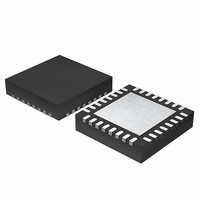EFM32G200F64 Energy Micro, EFM32G200F64 Datasheet - Page 30

EFM32G200F64
Manufacturer Part Number
EFM32G200F64
Description
MCU 32BIT 64KB FLASH 32-QFN
Manufacturer
Energy Micro
Series
Geckor
Datasheets
1.EFM32G200F16.pdf
(63 pages)
2.EFM32G200F16.pdf
(10 pages)
3.EFM32G200F16.pdf
(463 pages)
4.EFM32G200F16.pdf
(136 pages)
Specifications of EFM32G200F64
Core Processor
ARM® Cortex-M3™
Core Size
32-Bit
Speed
32MHz
Connectivity
EBI/EMI, I²C, IrDA, SmartCard, SPI, UART/USART
Peripherals
Brown-out Detect/Reset, DMA, POR, PWM, WDT
Number Of I /o
24
Program Memory Size
64KB (64K x 8)
Program Memory Type
FLASH
Ram Size
16K x 8
Voltage - Supply (vcc/vdd)
1.8 V ~ 3.8 V
Data Converters
A/D 4x12b, D/A 1x12b
Oscillator Type
External
Operating Temperature
-40°C ~ 85°C
Package / Case
32-VQFN Exposed Pad
Processor Series
EFM32G200
Core
ARM Cortex-M3
Data Bus Width
32 bit
Data Ram Size
16 KB
Interface Type
I2C, UART
Maximum Clock Frequency
32 MHz
Number Of Programmable I/os
24
Number Of Timers
2
Operating Supply Voltage
1.8 V to 3.8 V
Maximum Operating Temperature
+ 85 C
Mounting Style
SMD/SMT
Minimum Operating Temperature
- 40 C
Lead Free Status / RoHS Status
Lead free / RoHS Compliant
Eeprom Size
-
Lead Free Status / Rohs Status
Details
Available stocks
Company
Part Number
Manufacturer
Quantity
Price
- EFM32G200F16 PDF datasheet
- EFM32G200F16 PDF datasheet #2
- EFM32G200F16 PDF datasheet #3
- EFM32G200F16 PDF datasheet #4
- Current page: 30 of 463
- Download datasheet (8Mb)
7.3.5 Post-reset Behavior
7.3.5.1 One Wait-state Access
7.3.5.2 Zero Wait-state Access
7.3.5.3 Suppressed Conditional Branch Target Prefetch (SCBTP)
7.3.5.4 Cortex-M3 If-Then Block Folding
2010-09-06 - d0001_Rev1.00
The Revision number is to be interpreted according to Table 7.3 (p. 30) .
Table 7.3. Revision Number Interpretation
Calibration values are automatically written to registers by the MSC before application code startup. The
values are also available to read from the DI page for later reference by software. Other information
such as the device ID and production date is also stored in the DI page and is readable from software.
After reset, the HFCORECLK is normally 14 MHz from the HFRCO and the MODE field of the
MSC_READCTRL register is set to WS1 (one wait-state). The reset value must be WS1 as an
uncalibrated HFRCO may produce a frequency higher than 16 MHz. Software must not select a zero
wait-state mode unless the clock is guaranteed to be 16 MHz or below, otherwise the resulting behavior
is undefined. If a HFCORECLK frequency above 16 MHz is to be set by software, the MODE field of
the MSC_READCTRL register must be set to WS1 or WS1SCBTP before the core clock is switched to
the higher frequency clock source.
When changing to a lower frequency, the MODE field of the MSC_READCTRL register must be set to
WS0 or WS0SCBTP only after the frequency transition has completed. If the HFRCO is used, wait until
the oscillator is stable on the new frequency. Otherwise, the behavior is unpredictable.
At 16 MHz and below, read operations from flash may be performed without any wait-states. Zero wait-
state access greatly improves code execution performance at frequencies from 16 MHz and below.
By default, the Cortex-M3 uses speculative prefetching and If-Then block folding to maximize code
execution performance at the cost of additional flash accesses and energy consumption.
MSC offers a special instruction fetch mode which optimizes energy consumption by cancelling Cortex-
M3 conditional branch target prefetches. Normally, the Cortex-M3 core prefetches both the next
sequential instruction and the instruction at the branch target address when a conditional branch
instruction reaches the pipeline decode stage. This prefetch scheme improves performance while one
extra instruction is fetched from memory at each conditional branch, regardless of whether the branch is
taken or not. To optimize for low energy, the MSC can be configured to cancel these speculative branch
target prefetches. With this configuration, energy consumption is more optimal, as the branch target
instruction fetch is delayed until the branch condition is evaluated.
The performance penalty with this mode enabled is source code dependent, but is normally less than
1% for core frequencies from 16 MHz and below. To enable the mode at frequencies from 16 MHz and
below write WS0SCBTP to the MODE field of the MSC_READCTRL register. For frequencies above 16
MHz, use the WS1SCBTP mode. An increased performance penalty per clock cycle must be expected
in this mode compared to WS0SCBTP mode. The performance penalty in WS1SCBTP mode depends
greatly on the density and organization of conditional branch instructions in the code.
The Cortex-M3 offers a mechanism known as if-then block folding. This is a form of speculative
prefetching where small if-then blocks are collapsed in the prefetch buffer if the condition evaluates to
Revision[7:0]
0x00
0x01
...the world's most energy friendly microcontrollers
30
Revision
A
B
www.energymicro.com
Related parts for EFM32G200F64
Image
Part Number
Description
Manufacturer
Datasheet
Request
R

Part Number:
Description:
KIT STARTER EFM32 GECKO
Manufacturer:
Energy Micro
Datasheet:

Part Number:
Description:
KIT DEV EFM32 GECKO LCD SUPPORT
Manufacturer:
Energy Micro
Datasheet:

Part Number:
Description:
BOARD PROTOTYPING FOR EFM32
Manufacturer:
Energy Micro
Datasheet:

Part Number:
Description:
KIT DEVELOPMENT EFM32 GECKO
Manufacturer:
Energy Micro
Datasheet:

Part Number:
Description:
MCU, MPU & DSP Development Tools TG840 Sample Kit
Manufacturer:
Energy Micro
Datasheet:

Part Number:
Description:
MCU, MPU & DSP Development Tools TG Starter Kit
Manufacturer:
Energy Micro
Datasheet:

Part Number:
Description:
MCU, MPU & DSP Development Tools TG108 Sample Kit
Manufacturer:
Energy Micro

Part Number:
Description:
MCU, MPU & DSP Development Tools TG210 Sample Kit
Manufacturer:
Energy Micro
Datasheet:

Part Number:
Description:
MCU, MPU & DSP Development Tools TG822 Sample Kit
Manufacturer:
Energy Micro
Datasheet:

Part Number:
Description:
MCU, MPU & DSP Development Tools TG230 Sample Kit
Manufacturer:
Energy Micro

Part Number:
Description:
SAMPLE KIT (SMALL BOX - CONTAINING 2 DEVICES)
Manufacturer:
Energy Micro

Part Number:
Description:
SAMPLE KIT (SMALL BOX - CONTAINING 2 DEVICES)
Manufacturer:
Energy Micro











